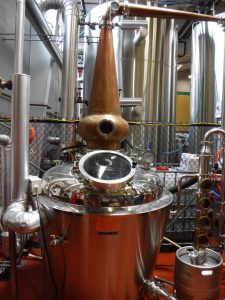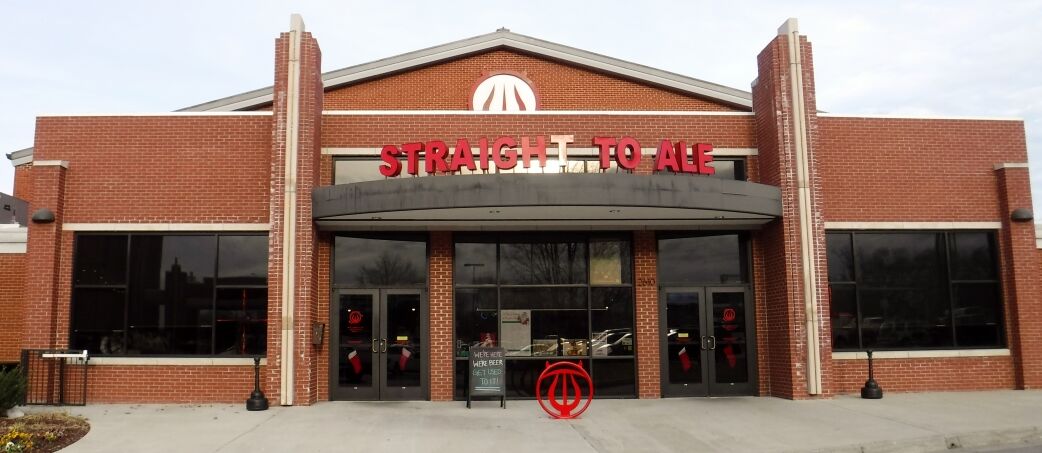A Renewal Story
I had the privilege of making a visit to one of Alabama’s largest production breweries. Located in Huntsville Alabama, Straight to Ale (STA) is more than just another craft brewery. Straight to Ale operates as a brewery, a distillery, a restaurant, and an arcade occupying 45,000 square feet in Huntsville’s Campus 805. Campus 805 began life in 1951 as one of Huntsville’s public high schools. In 1967, as the city grew, the campus transitioned into a middle school. However, once again, as the city’s needs changed, the school was closed and the property passed into private hands. Working together with the city and two anchor tenants, one of them Straight to Ale, the developer set about creating a multipurpose entertainment venue. The end result brings together not one, but two craft breweries and distilleries, Straight to Ale and Yellowhammer, with other restaurants, catering services, event venues, a public park, and even an axe throwing business, Civil Axe.
A Story of Growth
Straight to Ale began life as a home brewing operation, but shifted into the commercial world with a 500 square foot space in the old Lowe Mill, a factory given rebirth as an arts and craft center. As sales grew, the owners shifted operation to a 10,000 square foot facility on the south side of Huntsville. Eventually, the business began to outgrow that facility as well leading the owners to begin looking for the next step. That next step, taken hand in hand with the developer, was the creation of today’s location in Campus 805. This new, and much larger facility, allowed STA to grow not only in size, but to add the distillery, the restaurant, and the arcade to ensure they offered something for everyone.
One of the keys to Straight to Ale’s growth has been the evolving Federal and Alabama state laws pertaining to the craft brewing and distilling industries. Some changes, such as the tax relief provided by the recent US Tax Act of 2017, have allowed Straight to Ale to invest into their manufacturing operations, both in personnel and equipment. The elimination of Alabama laws such as the ones that prohibited onsite sales also helped fuel Straight to Ale’s growth. Nevertheless, legal barriers such as record keeping, and restrictions on onsite sales, still exist.
My guide for this visit was Kimberly, STA’s Marketing Director. She was extremely helpful in ensuring my many and detailed questions were answered, and that I had the opportunity to see everything I wanted to see at STA. Thank you again for a wonderful visit.
STA Brewery Operations
The heart and major driving force of STA is the brewery. They produce a wide variety of beers and ales, most of which is available on tap or in cans throughout Alabama. According to Bob, STA’s lead brewer, the brewery is making about 700 barrels of beer each month. Most of STA’s brewing equipment was purchased from Premier Stainless in California.
Monkeynaut India Pale Ale (IPA)

Monkeynaut IPA is an American IPA style beer with an alcohol by volume (ABV) of 7.25% and an International Bitterness Units (IBU) rating of 75. STA describes this beer as “citrusy, floral hop aroma, a strong malt body, and a crisp finish”. I love IPAs, especially with spicy foods, and I really enjoy this IPA. STA uses a mill system from Malt Handling LLC to mill all its source grains onsite. This allows them to pull from their silos of base malts on an as needed basis. Milling onsite helps them to produce a consistent product and facilitates the breakdown of sugars into alcohol.
STA uses a mash bill comprised of 2 row barley [https://www.midwestsupplies.com/differences-2row-6row] to produce Monkeynaut IPA. They add some Crystal Malt to the mash [https://byo.com/article/using-crystal-malt-techniques/] to add sweetness and color to the finished beer. STA uses a Centennial hop in Monkeynaut which creates a very nice balance of citrus and floral notes with the bitterness of the IPA style.
Monkeynaut IPA started from the founder’s homebrewing days and was scaled up and adjusted to match STA’s brewery equipment. This includes the choice of 75 IBUs since, according to STA, this is close to the original for this brew and is a perfect balance to the malty backbone. STA achieves this bitterness rating by adding several hop additions throughout the brew process along with a heavy doses of dry hopping. STA doesn’t use any other bittering agents in their Monkeynaut IPA.
Laika Bourbon Barrel Aged Russian Imperial Stout
According to STA this beer is a big bad Russian Imperial Stout that has lots of dark, crystal, chocolate, and flaked malts; along with a hearty amount of sweet molasses added in the boil. It is aged anywhere from 4-12months in used bourbon barrels. Laika is an adapted homebrew recipe, with an ABV of 10.1% that falls with the accepted style for stouts. I have not yet tried this beer, but it is on my have to do list for 2019.
STA Distillery Operations
STA’s still, which includes a 4 plate column, a 16 plate column and a gin basket, was purchased from Minnetonka Brewing & Equipment Company in Minnesota. They also have a small pilot still that they use to experiment with different products. The pilot still is currently being used to test producing absinthe.
Shelta Caverns Monkeynaut Whiskey

When I first reached out to STA to ask if I could visit and write a blog post, I told them I wanted to focus on their Light Whiskey offering. When I asked about the mashbill for this whiskey, the answer was Monkeynaut IPA beer. My perceptive response was “Huh? Do you mean you make it from beer?” The answer was yes, and Glenn and Cade, the STA distillers, then proceeded to educate me about German beer schnapps. Turns out those crafty Germans have been turning excess or even poorly brewed beer into a distilled spirit for centuries. It is however, not something that is done today on a large scale industrial basis. In fact, it’s not something that’s done much at all. In the US only few craft operations such as STA and Arcane Distilling are turning beer into whiskey.
As we were discussing this amazing (to me) whiskey Glenn quickly poured up a small sample of the Whiskeynaut white dog for me. The aroma was incredibly floral, without any hint of the unpleasant congeners typical of white dog. Glenn explained that they distill the whiskey to 180 proof, nearly the level of vodka, thereby removing most of the non-ethanol compounds. The whiskey is distilled twice, first a stripping run using only the still, followed by a spirits run using the still and the 4 plate column. The raw whiskey goes into new oak barrels with a 3 or 4 level char at 100 to 120 proof. Oak chips are added to accelerate the aging process. Despite the high proof, the hops in the beer power through to give the distillate its wonderful floral aroma. Glenn then gave me a sample of the finished aged whiskey, which is bottled at 80 proof. Again, the wonderful floral notes were there, both in my nose and on my palate. The color was a nice pale amber reminiscent of a good scotch.
Shelta Caverns Gin
The gin uses a mash bill of 2-row barley and wheat, a dry yeast produced specifically for neutral washes, and juniper berries for flavor. The first step in making this spirit is to create a 190 proof distillate using the sixteen plate column. Fundamentally, this first run produces a spirit that could be sold as a vodka. This distillate is then diluted and redistilled through the gin basket at 100 proof which creates the characteristic gin flavor. The finished distillate is cut to 80 proof and then bottled.

Very Interesting and Informative.